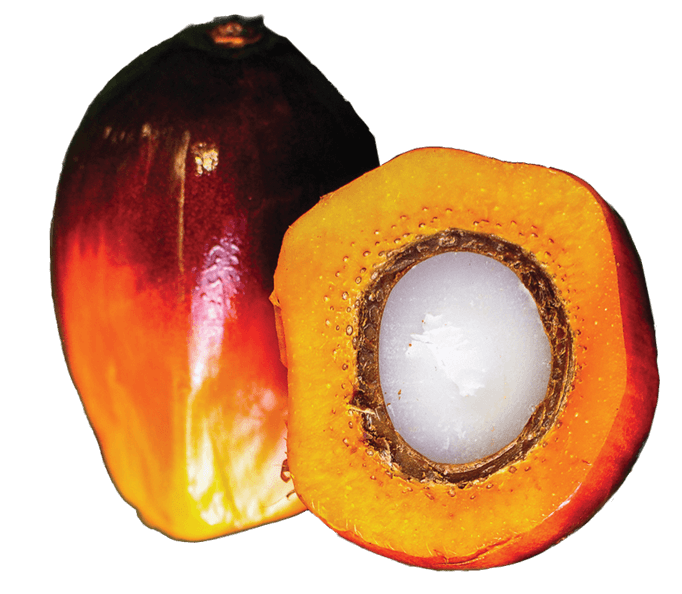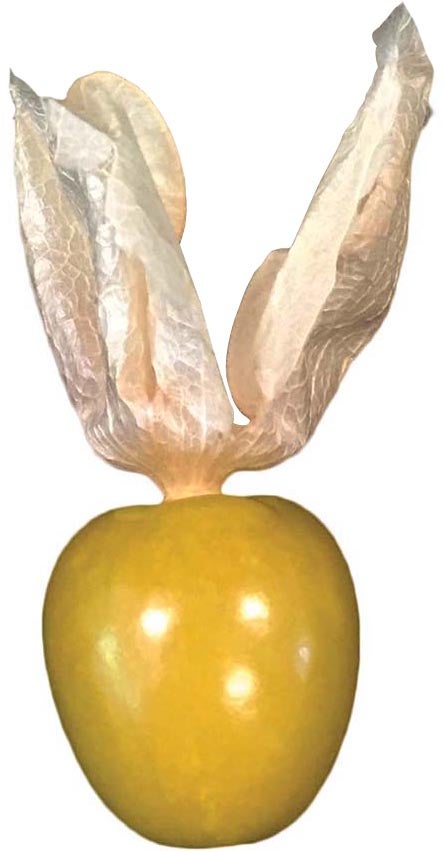As we advance toward the middle of the twenty-first century, humanity faces an existential challenge: figuring out how to feed the world’s rapidly growing population in the face of climate change and the increasingly limited availability of key nutrients and suitable land for farming. We need solutions that are local, national and global to increase food production in spite of these threats to our livelihood, and to do so on what is an ever smaller amount of suitable land. Cold Spring Harbor Laboratory’s (CSHL) biologists pursuing fundamental discovery research are critical to these solutions.
The challenges defined
 It’s important to start with some facts that precisely define the challenge. By 2050, the world’s population is expected to reach almost 10 billion, from 7 billion today. According to the U.N., nearly 821 million people suffered from chronic food deprivation in 2017, up from 804 million in 2016. Those numbers are expected to continue to rise. Meanwhile, climate change and related extreme events have been a major cause of food shortages and damage to the world’s ecosystems.
It’s important to start with some facts that precisely define the challenge. By 2050, the world’s population is expected to reach almost 10 billion, from 7 billion today. According to the U.N., nearly 821 million people suffered from chronic food deprivation in 2017, up from 804 million in 2016. Those numbers are expected to continue to rise. Meanwhile, climate change and related extreme events have been a major cause of food shortages and damage to the world’s ecosystems.
On top of this upheaval, over-farming and other factors have degraded much of the world’s soil, leaving it too salty for agricultural use. Nitrogen, an essential nutrient for crops that is at once dangerously scarce in its availability as a fertilizer, and is also detrimental to the environment and to humans when not managed efficiently, has been polluting our land, air and water. Phosphorus, another crucial nutrient for plants and for our survival, is simultaneously in short supply where it is needed, and harming the environment where it is found in excess.
Of course, there are political, infrastructural, economic, and social factors contributing to the globe’s food shortages. The pressures are coming from multiple points. But science—and specifically, the kind of fundamental discovery research that is conducted at Cold Spring Harbor Laboratory—may very well be our best hope for meeting and beating these challenges.
Biological roots of agriculture
 Plant biology research at CSHL explores fundamental mechanisms in plant development and genetics, and this kind of discovery research underlies all innovations that have the potential to combat nutrient shortages and poor adaption of plants to changing environments, and to improve crop productivity to feed the growing population. CSHL scientists have made and are continuing to make pioneering discoveries that help explain how plants adapt to different and changing environments, and how we can influence their ability to do so; they are exploring the possibilities of adapting non-traditional, wild or “orphan” crops for large-scale agriculture, expanding our selection of major food sources; and they are making impressive headway in the quest to increase yields of existing staple crops. Their experimentation can lead to remarkable results and real-world impacts.
Plant biology research at CSHL explores fundamental mechanisms in plant development and genetics, and this kind of discovery research underlies all innovations that have the potential to combat nutrient shortages and poor adaption of plants to changing environments, and to improve crop productivity to feed the growing population. CSHL scientists have made and are continuing to make pioneering discoveries that help explain how plants adapt to different and changing environments, and how we can influence their ability to do so; they are exploring the possibilities of adapting non-traditional, wild or “orphan” crops for large-scale agriculture, expanding our selection of major food sources; and they are making impressive headway in the quest to increase yields of existing staple crops. Their experimentation can lead to remarkable results and real-world impacts.
Groundbreaking discoveries in genetics and plant biology have been taking place in Cold Spring Harbor for well over a century. Charles Davenport, funded by the Carnegie Institution, established a study center for genetics here in 1904 that soon produced truly impactful results. Botanist George Harrison Shull’s fundamental work here culminated in a 1908 paper, “The Composition of a Field of Maize,” which led to the use of heterosis or “hybrid vigor”—the tendency of a crossbred individual to show qualities far superior to both parents—in plant breeding. When later introduced to farmers, this technology dramatically increased maize crop yield for both animal and human consumption, turning corn into this country’s most valuable crop.

In the 1940s, Barbara McClintock discovered that genetic information is not stationary by identifying DNA elements in the genome of corn that she called “transposable elements.” These elements could jump around the genome—and when landing near a gene, they take control of that gene by affecting the surrounding genetic material. McClintock’s discoveries laid the groundwork for understanding how genes can be controlled in plants, and she received the 1983 Nobel Prize for Physiology or Medicine for her pioneering work.
Shull and McClintock’s research was foundational to the field of plant biology, and revolutionary in its day. Today, it is thrilling to see the next great plant science revolution taking place at the Laboratory. We have begun to understand and map the genomic sequences of plants, and to use those insights and knowledge to make crops and other plants heartier, more adaptable, and more robust—all at an unprecedented rate of discovery. Indeed, a second green revolution is beginning.
The yield of genomic data
 We are now in the age of genome biology—and that includes the sequencing of plant genomes. The first plant genome to be sequenced was that of the popular model plant organism, Arabidopsis thaliana, and was accomplished with substantial input from CSHL scientists Dick McCombie and Rob Martienssen. More recently, genome sequencing of many plant genomes, particularly the staple crops like sorghum, maize, wheat and rice that are critical to food security in countries across the globe, has helped plan new approaches to crop improvement.
We are now in the age of genome biology—and that includes the sequencing of plant genomes. The first plant genome to be sequenced was that of the popular model plant organism, Arabidopsis thaliana, and was accomplished with substantial input from CSHL scientists Dick McCombie and Rob Martienssen. More recently, genome sequencing of many plant genomes, particularly the staple crops like sorghum, maize, wheat and rice that are critical to food security in countries across the globe, has helped plan new approaches to crop improvement.
Exemplifying CSHL’s open and collaborative spirit, Dick McCombie and plant biologist Doreen Ware are committed to generating genome sequences and building genomic databases that can be utilized by scientists anywhere, in the interest of improving the yield and range of modern plants. For example, McCombie has been involved in a multinational program to analyze the genome of an important food legume crop that is grown in the semi-arid regions of the world.
By comparing the genomes of plants of the same lineage, Ware is part of a large international consortium gaining key insights into gene conservation and loss, gene regulation, and gene expression of these plants, including studies that compare 13 varieties of rice. In other work, the sequencing of the genome of sorghum plants and identifying mutations in a gene that regulates hormone production have made it possible to triple the number of grains each plant produces. Also in 2018, genome analysis of Arabidopsis uncovered a set of gene regulators that are key to understanding nitrogen metabolism.
Discovering biological principles related to how plants reproduce, how they develop and how they control their shape and yield of flowers and fruit is a core component of the plant biology group at Cold Spring Harbor Laboratory. Rob Martienssen has done leading-edge work in plants’ “secondary” genetic code—the epigenome. This work by Martienssen, who was mentored by and worked closely with McClintock for his first two years at CSHL, starting in 1989, has far-reaching implications for plant breeding, bioenergy, and human health. In 2018, he was honored with the Barbara McClintock Prize for Plant Genetics and Genome Studies at the Maize Genetics Conference in Saint-Malo, France. This award recognized decades of work piecing together an understanding of how the several interacting layers of epigenetic signals in plants function, and how they work together to regulate gene activity.
For example, by studying modifications in the DNA of cloned palm oil plants, Martienssen and colleagues in the United States, Malaysia and Indonesia developed a simple and inexpensive DNA test that will greatly improve the productivity of farms that produce palm oil, thereby reducing the need for farmers to acquire more land by invading nearby rain forests. In addition to important, fundamental discoveries about how genes are controlled in plants, Martienssen has identified methods that can generate plant embryos without fertilization, thereby limiting the variegation that occurs with classical plant breeding.
This research is helping us understand how to increase crop yields and make plants more adaptable to changing environmental conditions. In other projects, Martienssen is pioneering research into using a diminutive but plentiful aquatic plant called duckweed as a sustainable source of biofuel. This contributes to tackling another major challenge of our time—humanity’s dependence on fossil fuels.
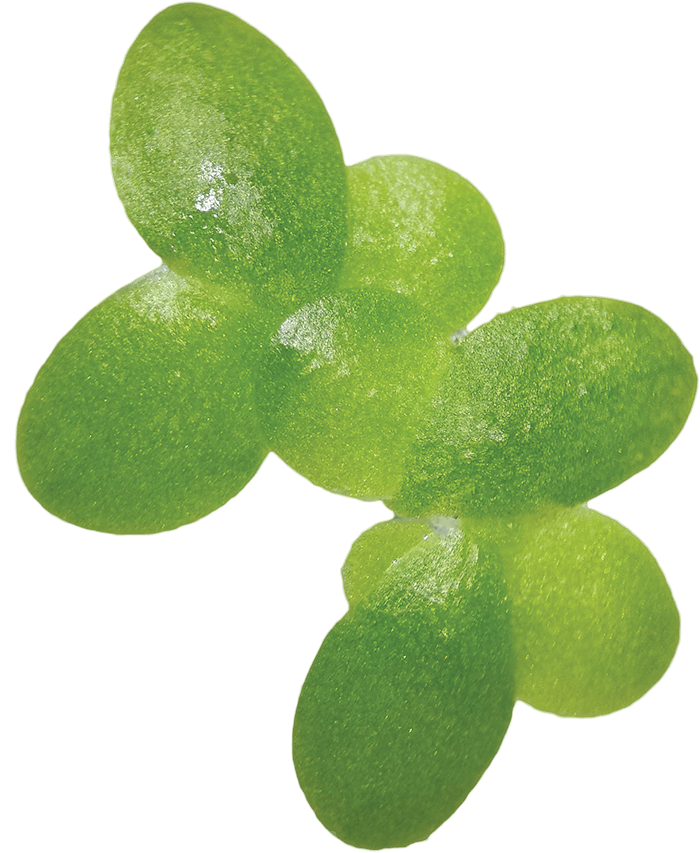
Improvements in yield of major crops also come from discovery research aimed at understanding how stem cells in the growing tips of plants, called meristems, develop into various tissues. David Jackson, who together with Martienssen has built up the CSHL plant biology group, studies how the shoot meristem cells differentiate into the inflorescences that produce flowers and ultimately seeds, which in maize are the kernels on the cob. Jackson has shown that regulatory proteins can move between cells in the plant, an unexpected finding.
Jackson has also studied the function of signaling proteins that, when manipulated, can increase the size of the meristem, ultimately resulting in more rows of maize kernels on the cob, hence increasing yield per plant. His insights into stem cell biology and cell-to-cell signaling come from the powerful genetic tools in maize, as well as his studies on the model plant Arabidopsis. The results of his work are readily translated into crop species because of the conserved pathways that determine plant development.
Nurturing new technologies
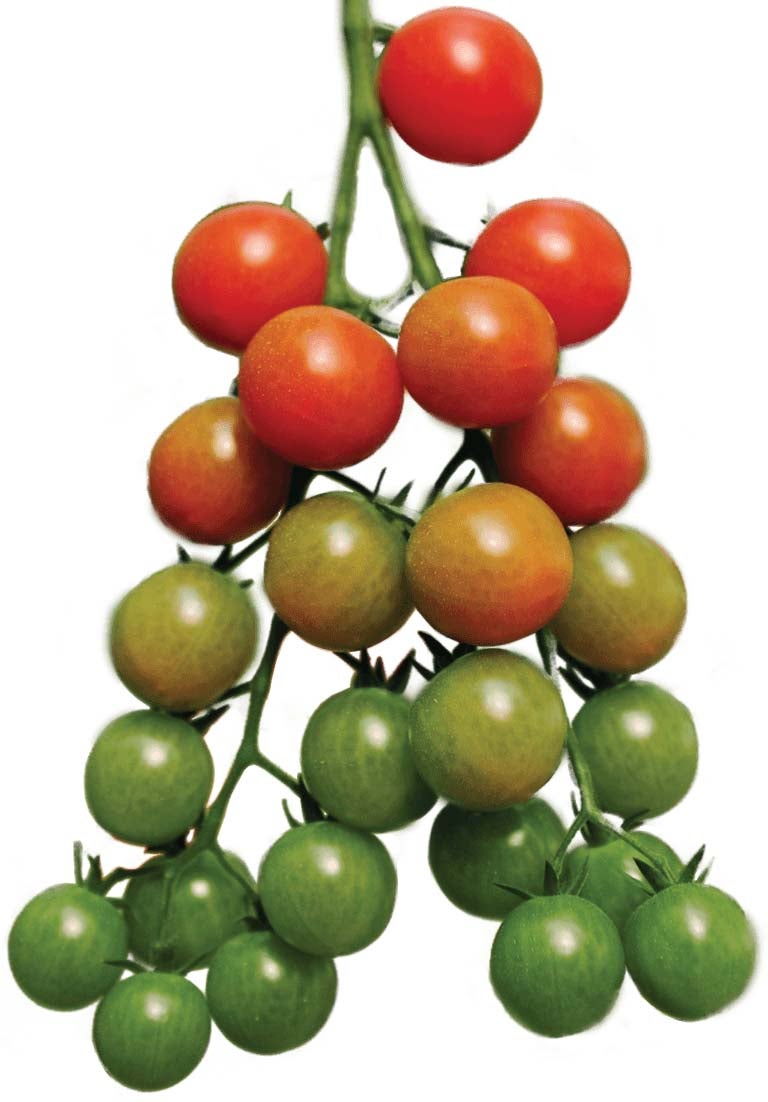 It is a testament to the Laboratory’s sustained reputation as a deeply supportive and welcoming institution that so many of our scientists come here and stay here as a result not only of the science being done, but of the relationships they form with their colleagues, mentors, and students. Martienssen admired and built upon the seminal work of McClintock, and in turn, he mentored now-Professor Zach Lippman when Lippman first came to CSHL as a graduate student in 2000.
It is a testament to the Laboratory’s sustained reputation as a deeply supportive and welcoming institution that so many of our scientists come here and stay here as a result not only of the science being done, but of the relationships they form with their colleagues, mentors, and students. Martienssen admired and built upon the seminal work of McClintock, and in turn, he mentored now-Professor Zach Lippman when Lippman first came to CSHL as a graduate student in 2000.
Lippman studies the genes that are responsible for the number and location of inflorescences, or flower-producing branches, on tomato plants, and he has used the CRISPR/Cas9 gene editing tool to make extraordinary advances in fine-tuning plant architecture and flower production. While mechanistic discovery science is the bedrock of CSHL’s scientific program, Lippman’s work is a shining example of how the work we do here to understand plant biology can lead—and lead quickly—to extraordinary translational benefits.
Lippman has studied the genetics of hybrid vigor, following up on Shull’s ideas of more than a century ago. Lippman has shown that the levels of hormones in a plant and the exact makeup or ratio of multiple genes that determine these hormone levels contribute to hybrid vigor, or heterosis. In addition, Lippman, in a collaboration with Jackson, has used CRISPR/Cas9 gene editing to make a series of mutations in the DNA that controls the expression of genes, called a promoter. By making many such promoter mutations in genes that control expression of hormones, plants can be created with specific characteristics like fruit number and size. Other promoter mutations could help plants better adjust to growing environments in specific locations, thereby increasing the potential geographic area in which crops can grow.
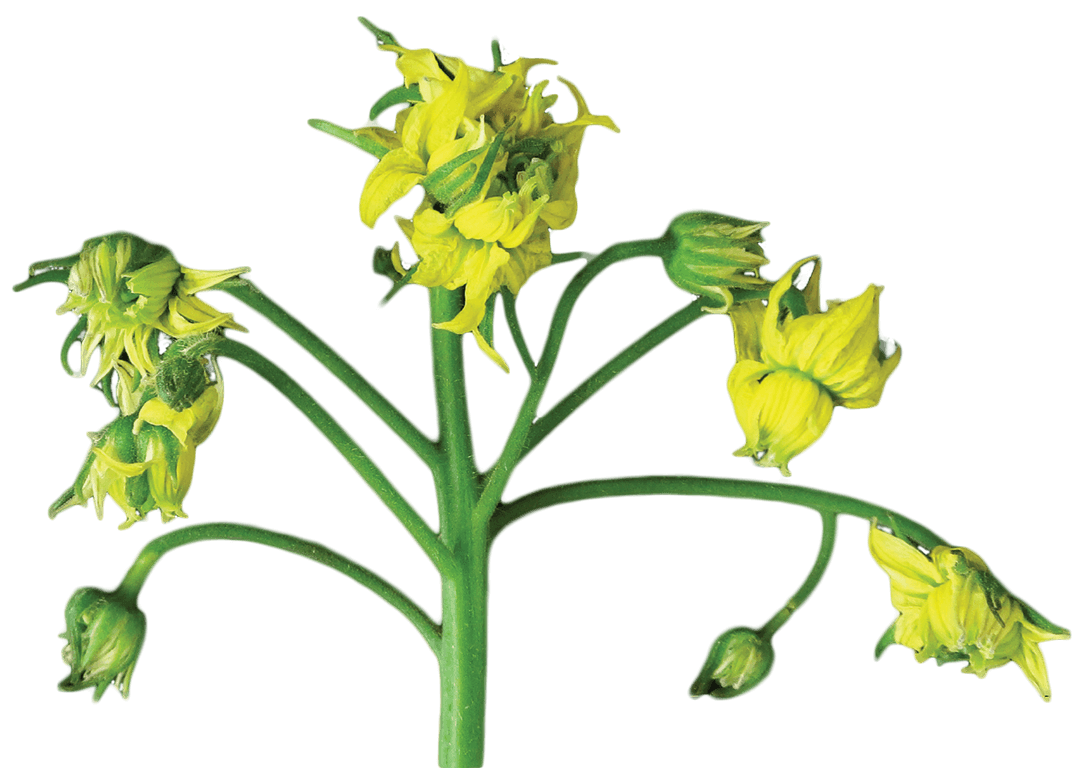
CSHL has licensed this Promoter Fine Tuning technology and other inventions of our plant biology group to the plant breeding industry. Whereas commercial production of soybean, corn, wheat, tomato, and other crops has historically been constrained by the availability of just a few standard seed varieties (varieties that may not be ideally suited to the growing conditions where they are planted), the new technology will eventually offer farmers the ability to purchase seeds customized to the specific growing conditions of their fields. Seeds for plants that are better suited to the currently available growing locations and conditions will mean increases in plant yields or the growth of crops that are tuned to use water and nitrogen more efficiently. And as the climate continues to change, we can much more swiftly and easily adapt crop planting to the growing conditions that arise.
Indeed, thanks to fundamental discovery research in this genome age, the rate of discovery in plant biology has increased and new technologies can be implemented relatively quickly. As the leap from discovery science to field trials has become increasingly less expensive, the process has also been democratized. Small companies and developing nations are able to use technologies to augment the traditional, large multi-national plant industry offerings—with potentially transformative positive implications for future food security.
Lippman has also used CRISPR technology to tweak the genes of the groundcherry, a small and historically wild relative of the tomato, with the hope of rendering it suitable for larger-scale agriculture. His work illustrates the possibility that new strains of traditionally wild crops—yet untapped food sources—could be bred relatively quickly for large-scale crop farming.
The most recent faculty member in the productive and influential CSHL plant biology program, Ullas Pedmale, is helping us understand how plants modulate their own growth and development by sensing the environment around them. By studying how plants use information about both biotic and abiotic aspects of their environment—temperature, light quality and quantity, herbivores, pathogens, water availability, and more—to direct their own growth, he is investigating ways to develop crops that can adapt efficiently to unfavorable environments, like those that will inevitably arise from our changing climate, without decreases in yield.
A way forward
The challenge of growing crops to feed billions of people, on a total amount of suitable land that is rapidly diminishing, is formidable. But the basic research I’ve described, and the research that we’ll continue to pursue, gives us reason to believe that we can help plants adapt to conditions like hotter temperatures, soil salinity, infections, and water shortages. Since the institution’s inception, CSHL and its scientists have dedicated themselves to the fundamental discovery research that is essential to tackling some of the world’s most complex and intimidating problems. For the past 129 years, CSHL scientists have made major advances in many research areas, but particularly notable has been the impact of CSHL in plant biology. Thus, as challenges of population growth and climate change face us, we look toward the new green revolution to help address such issues.
— Bruce Stillman
President & Chief Executive Officer
About

Bruce Stillman
President and Chief Executive Officer
Oliver R. Grace Professor
Cancer Center Member
Ph.D., Australian National University, 1979


